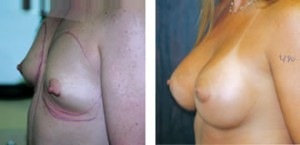Scarless Breast Augmentation
Posted On: July 18, 2008 Author: The Office of Dr. Stuart Linder Posted In: Breast Augmentation

Breast augmentation can be performed through many different methods, including periareolar (under the nipple), transaxillary (through the armpit), inframammary (under the breast crease) or transumbilical (through the umbilicus).
“The Scarless Breast Augmentation, is it worth it?”
The scarless breast augmentation would be considered a procedure where there is no incision on the breast such as a transumbilical. The problem with transumbilical augmentation is although good results may be obtainable, there is a much higher rate of malposition of the implant, with the implant being placed in the improper position.
If you think in common sense, going from the umbilicus or belly button all the way up to the submuscular breast area is a very long way to track predictability of placing the implant perfectly is very difficult, even in the best hands. Think in a synonymous manner, such as in the world of golf. It is much easier for Tiger Woods to hit a 2 foot putt than it is to hit a 25 foot putt. In other words, placing an implant under the nipple allows you to probably release the muscle directly upon the muscle rather than trying to release the muscle through the belly button is a very long, long track or a long putt, even for the best of hands.
Problems with Scarless Breast Augmentation
The problem with transumbilical augmentation (scarless breast augmentation) is that there is a significant chance that the implants will be placed too far or too high, which means the patient may have superior retropositioning of the implant with the implants too high and the parasternal attachments of the muscle may not be released properly as well as along the parasternal area which may lead to poor sternal cleavage.
Implant positioning is absolutely essential in breast augmentation surgery. When we perform and place over 1000 breast implants annually, positioning the implant in the proper position time after time after time is absolutely essential.
Therefore, by going through the inferior areola, the scars first of all heal quite nicely in the majority of patients. Second, I can very easily safely and predictably release the pectoralis muscle and produce a pocket that is precise. Also, dissection of tissue lateral to the areola can be performed very precisely and thereby the implant vector force can be towards the middle of the chest which would increase and give a more beautiful cleavage rather than an unpredictable release of tissue laterally, which will cause the breast implants to be too far to the side, something that our patients absolutely despise.
Therefore, when considering breast augmentation and the so-called scarless technique of transumbilical, think in your mind what your final goal is. Is it more important to have a predictable result with the implants placed properly thereby lining up the inframammary fold, the nipple and enhancing cleavage, or is it more important to have no scar whatsoever on the chest and have the implants placed in a possibly more unpredictable and haphazard manner.
Stuart A. Linder, M.D.